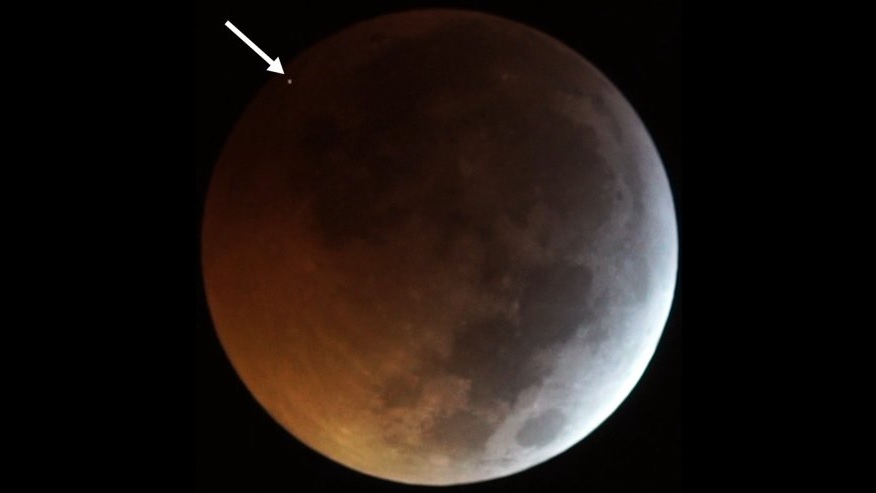Pow! A Meteorite Slammed into the Moon at 38,000 MPH During Lunar Eclipse
If you blinked, you missed it.
A meteorite smashed into the moon's surface at 38,000 miles per hour (61,000 kilometers per hour) while our lunar neighbor was in total eclipse in January, a new report reveals.
Observers saw a flash during the Jan. 20 to 21 eclipse, when the object collided with the moon and carved out a crater about 10 to 15 meters (33 to 50 feet) in diameter. It was traveling fast enough to have been able to cross the United States in just a few minutes, but, luckily for Earth, it slammed into the moon instead.
Astronomers measured a 0.28-second flash from the impact, the first ever filmed during a lunar eclipse. Lunar eclipses happen when the moon passes into the Earth's shadow during its normal orbit around our planet. The moon turns a reddish or orange color, because only sunlight around the edges of Earth's shadow can reach the moon's surface.
Related: Record Meteorite Crash on Moon Is Brightest Lunar Explosion Ever
"Something inside of me told me that this time would be the time," Jose Maria Madiedo, an astrophysicist at the University of Huelva in Spain and lead author on the new study, said in a statement. Madiedo and fellow astrophysicist Jose Ortiz, of the Institute of Astrophysics of Andalusia, caught the flash on video using the Moon Impacts Detection and Analysis System (MIDAS). MIDAS is a network of eight telescopes in southern Spain that monitors the moon's surface.
MIDAS monitored the flash in different wavelengths, revealing more information about the space rock that hit the moon. Scientists estimated the rock was about 45 kg (100 lbs.) in mass and roughly 30 to 60 centimeters (1 foot to 2 feet) across.
After the impactor crashed into the surface, the debris it generated had an estimated peak temperature that was about as hot as the surface of the sun — about 9,750 degrees Fahrenheit (5,400 degrees Celsius).
Get the Space.com Newsletter
Breaking space news, the latest updates on rocket launches, skywatching events and more!
Related: Amazing Photos of the 2019 Super Blood Wolf Moon!

Researchers said in the statement that the moon is hit by small rocks more often than Earth because it has only a tenuous atmosphere, while Earth's is thick enough for many space rocks to burn up before they can reach the surface.
The scientists added that observing the flash was especially valuable because they cannot duplicate it on our own planet.
"It would be impossible to reproduce these high-speed collisions in a lab on Earth. Observing flashes is a great way to test our ideas on exactly what happens when a meteorite collides with the moon," Madiedo said.
The scientists added that knowing the rate of lunar collisions will be especially important in the protection of the safety of astronauts, who may venture back to the surface of the moon as soon as 2024.
The new research was detailed April 27 in the journal Monthly Notices of the Royal Astronomical Society.
- The Super Blood Wolf Moon Looks AMAZING in These Pics
- Impact! New Moon Craters Are Appearing Faster Than Thought
- The Moon's Surface Is Totally Cracked
Follow Elizabeth Howell on Twitter @howellspace. Follow us on Twitter @Spacedotcom and on Facebook.
Join our Space Forums to keep talking space on the latest missions, night sky and more! And if you have a news tip, correction or comment, let us know at: community@space.com.

Elizabeth Howell (she/her), Ph.D., was a staff writer in the spaceflight channel between 2022 and 2024 specializing in Canadian space news. She was contributing writer for Space.com for 10 years from 2012 to 2024. Elizabeth's reporting includes multiple exclusives with the White House, leading world coverage about a lost-and-found space tomato on the International Space Station, witnessing five human spaceflight launches on two continents, flying parabolic, working inside a spacesuit, and participating in a simulated Mars mission. Her latest book, "Why Am I Taller?" (ECW Press, 2022) is co-written with astronaut Dave Williams.








